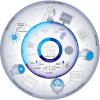PEDOT:PSS-based bioelectronics for brain monitoring and modulation
- PMID: 40360495
- PMCID: PMC12075682
- DOI: 10.1038/s41378-025-00948-w
PEDOT:PSS-based bioelectronics for brain monitoring and modulation
Abstract
The growing demand for advanced neural interfaces that enable precise brain monitoring and modulation has catalyzed significant research into flexible, biocompatible, and highly conductive materials. PEDOT:PSS-based bioelectronic materials exhibit high conductivity, mechanical flexibility, and biocompatibility, making them particularly suitable for integration into neural devices for brain science research. These materials facilitate high-resolution neural activity monitoring and provide precise electrical stimulation across diverse modalities. This review comprehensively examines recent advances in the development of PEDOT:PSS-based bioelectrodes for brain monitoring and modulation, with a focus on strategies to enhance their conductivity, biocompatibility, and long-term stability. Furthermore, it highlights the integration of multifunctional neural interfaces that enable synchronous stimulation-recording architectures, hybrid electro-optical stimulation modalities, and multimodal brain activity monitoring. These integrations enable fundamentally advancing the precision and clinical translatability of brain-computer interfaces. By addressing critical challenges related to efficacy, integration, safety, and clinical translation, this review identifies key opportunities for advancing next-generation neural devices. The insights presented are vital for guiding future research directions in the field and fostering the development of cutting-edge bioelectronic technologies for neuroscience and clinical applications.
© 2025. The Author(s).
Conflict of interest statement
Conflict of interest: The authors declare no competing interests.
Figures





Similar articles
-
Design Strategies of PEDOT:PSS-Based Conductive Hydrogels and Their Applications in Health Monitoring.Polymers (Basel). 2025 Apr 27;17(9):1192. doi: 10.3390/polym17091192. Polymers (Basel). 2025. PMID: 40362976 Free PMC article. Review.
-
PEDOT-based stretchable optoelectronic materials and devices for bioelectronic interfaces.Chem Soc Rev. 2024 Oct 28;53(21):10575-10603. doi: 10.1039/d4cs00541d. Chem Soc Rev. 2024. PMID: 39254255 Review.
-
3D printing of highly conductive and strongly adhesive PEDOT:PSS hydrogel-based bioelectronic interface for accurate electromyography monitoring.J Colloid Interface Sci. 2025 Jan;677(Pt A):198-207. doi: 10.1016/j.jcis.2024.05.171. Epub 2024 May 23. J Colloid Interface Sci. 2025. PMID: 38816323
-
Highly Conductive PPy-PEDOT:PSS Hybrid Hydrogel with Superior Biocompatibility for Bioelectronics Application.ACS Appl Mater Interfaces. 2021 Jun 2;13(21):25374-25382. doi: 10.1021/acsami.1c04432. Epub 2021 May 19. ACS Appl Mater Interfaces. 2021. PMID: 34009925
-
Boosting the Performance of PEDOT:PSS Based Electronics Via Ionic Liquids.Adv Mater. 2024 Mar;36(13):e2310973. doi: 10.1002/adma.202310973. Epub 2024 Jan 17. Adv Mater. 2024. PMID: 38185875 Review.
Cited by
-
Recent Advances in Flexible Sensors for Neural Interfaces: Multimodal Sensing, Signal Integration, and Closed-Loop Feedback.Biosensors (Basel). 2025 Jul 2;15(7):424. doi: 10.3390/bios15070424. Biosensors (Basel). 2025. PMID: 40710074 Free PMC article. Review.
References
-
- Kim, M., Lee, H., Nam, S., Kim, D.-H. & Cha, G. D. Soft bioelectronics using nanomaterials and nanostructures for neuroengineering. Acc. Chem. Res.57, 1633–1647 (2024). - PubMed
-
- Koo, J. H., Song, J.-K., Kim, D.-H. & Son, D. Soft implantable bioelectronics. ACS Mater. Lett.3, 1528–1540 (2021).
-
- Li, J., Cao, J., Lu, B. & Gu, G. 3D-printed PEDOT:PSS for soft robotics. Nat. Rev. Mater.8, 604–622 (2023).
-
- Li, G. et al. Highly conducting and stretchable double-network hydrogel for soft bioelectronics. Adv. Mater.34, 2200261 (2022). - PubMed
Publication types
Grants and funding
- 30802-110690303/Guangdong Science and Technology Department (Science and Technology Department, Guangdong Province)
- 2021ZD0204300/National Science Foundation of China | Major Research Plan
- MYRGGRG2023-00038-FHS/Universidade de Macau (University of Macau)
- 28709-312200502501/Beijing Normal University (BNU)
LinkOut - more resources
Full Text Sources
